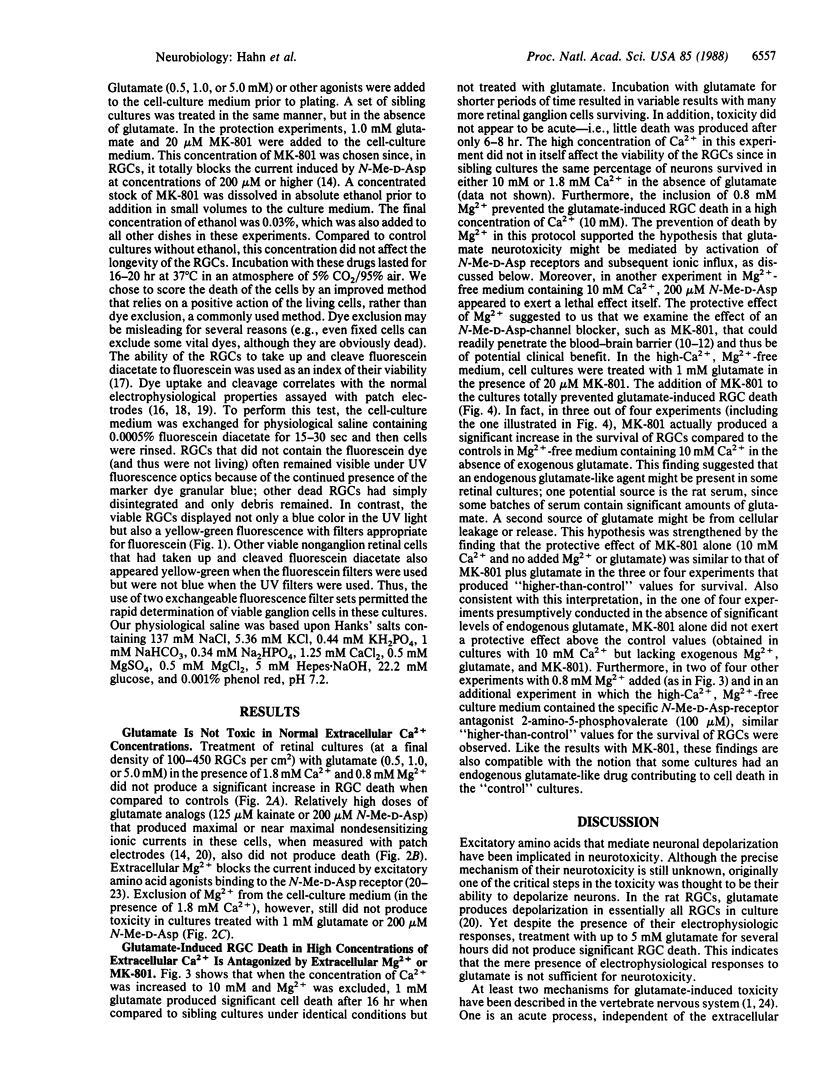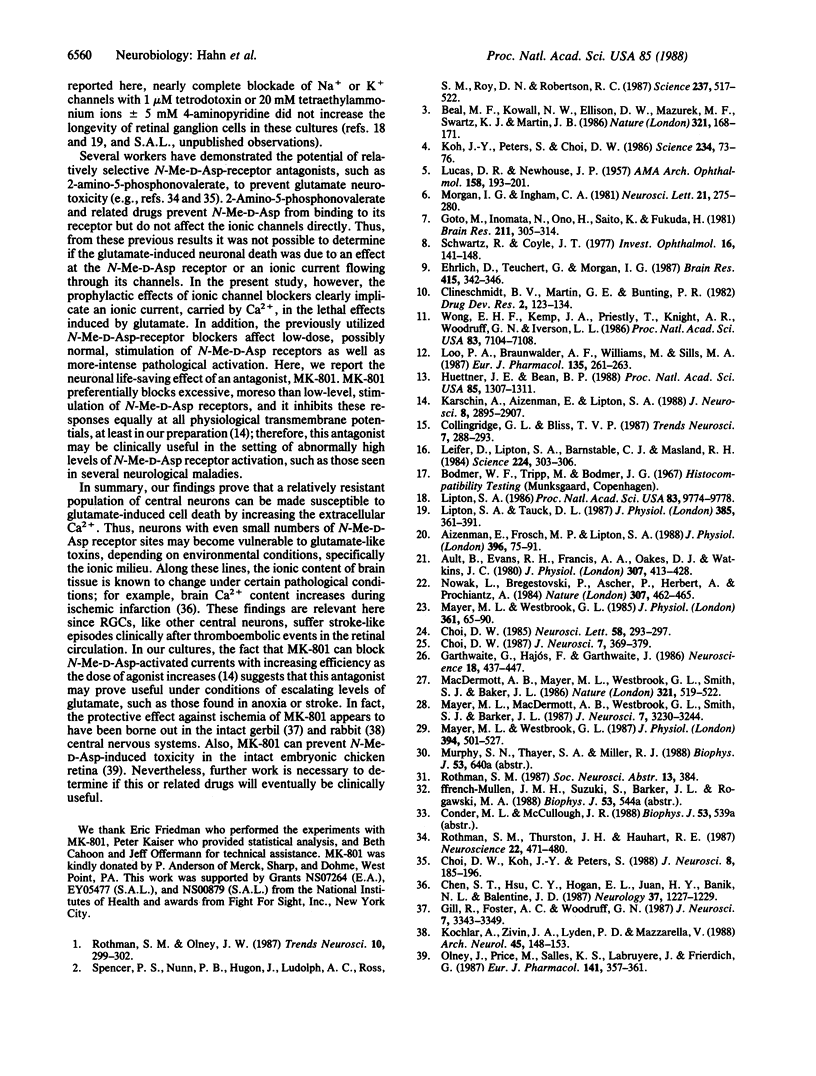Abstract
It is widely held that a glutamate-like toxin that resembles N-methyl-D-aspartate may be responsible for the death of nerve cells seen after severe neurological insults including stroke, seizures, and degenerative disorders, such as Huntington disease, Alzheimer disease, and the amyotrophic lateral sclerosis-parkinsonism-dementia complex found on Guam. One puzzling fact about these maladies is the differential vulnerability of specific groups of neurons peculiar to each condition. We report here that an identified population of central neurons, rat retinal ganglion cells, are resistant to the neurotoxic effects of millimolar concentrations of glutamate under otherwise normal culture conditions. Patch-clamp experiments show that this resistance is associated with a very small ionic current response to N-methyl-D-aspartate. Varying the ionic milieu by increasing the extracellular Ca2+ concentration, however, results in a striking increase in glutamate-induced cell death in this population. Under these conditions, Mg2+ or the amino acid antagonist MK-801 [(+)-5-methyl-10,11-dihydro-5H-dibenzo-(alpha,gamma)-cyclohepten-5 ,10-imine maleate], blockers of N-methyl-D-aspartate receptor-coupled ion channels, completely abrogate the lethal effects of glutamate. These findings strongly suggest that Ca2+ entry through N-methyl-D-aspartate-activated channels is responsible for this type of neuronal death and suggest strategies that may be clinically useful in the treatment of various neurological disorders.
Full text
PDF




Images in this article
Selected References
These references are in PubMed. This may not be the complete list of references from this article.
- Aizenman E., Frosch M. P., Lipton S. A. Responses mediated by excitatory amino acid receptors in solitary retinal ganglion cells from rat. J Physiol. 1988 Feb;396:75–91. doi: 10.1113/jphysiol.1988.sp016951. [DOI] [PMC free article] [PubMed] [Google Scholar]
- Ault B., Evans R. H., Francis A. A., Oakes D. J., Watkins J. C. Selective depression of excitatory amino acid induced depolarizations by magnesium ions in isolated spinal cord preparations. J Physiol. 1980 Oct;307:413–428. doi: 10.1113/jphysiol.1980.sp013443. [DOI] [PMC free article] [PubMed] [Google Scholar]
- Beal M. F., Kowall N. W., Ellison D. W., Mazurek M. F., Swartz K. J., Martin J. B. Replication of the neurochemical characteristics of Huntington's disease by quinolinic acid. Nature. 1986 May 8;321(6066):168–171. doi: 10.1038/321168a0. [DOI] [PubMed] [Google Scholar]
- Chen S. T., Hsu C. Y., Hogan E. L., Juan H. Y., Banik N. L., Balentine J. D. Brain calcium content in ischemic infarction. Neurology. 1987 Jul;37(7):1227–1229. doi: 10.1212/wnl.37.7.1227. [DOI] [PubMed] [Google Scholar]
- Choi D. W. Glutamate neurotoxicity in cortical cell culture is calcium dependent. Neurosci Lett. 1985 Aug 5;58(3):293–297. doi: 10.1016/0304-3940(85)90069-2. [DOI] [PubMed] [Google Scholar]
- Choi D. W. Ionic dependence of glutamate neurotoxicity. J Neurosci. 1987 Feb;7(2):369–379. doi: 10.1523/JNEUROSCI.07-02-00369.1987. [DOI] [PMC free article] [PubMed] [Google Scholar]
- Choi D. W., Koh J. Y., Peters S. Pharmacology of glutamate neurotoxicity in cortical cell culture: attenuation by NMDA antagonists. J Neurosci. 1988 Jan;8(1):185–196. doi: 10.1523/JNEUROSCI.08-01-00185.1988. [DOI] [PMC free article] [PubMed] [Google Scholar]
- Ehrlich D., Teuchert G., Morgan I. G. Specific ganglion cell death induced by intravitreal kainic acid in the chicken retina. Brain Res. 1987 Jul 14;415(2):342–346. doi: 10.1016/0006-8993(87)90217-4. [DOI] [PubMed] [Google Scholar]
- Garthwaite G., Hajós F., Garthwaite J. Ionic requirements for neurotoxic effects of excitatory amino acid analogues in rat cerebellar slices. Neuroscience. 1986 Jun;18(2):437–447. doi: 10.1016/0306-4522(86)90164-8. [DOI] [PubMed] [Google Scholar]
- Gill R., Foster A. C., Woodruff G. N. Systemic administration of MK-801 protects against ischemia-induced hippocampal neurodegeneration in the gerbil. J Neurosci. 1987 Oct;7(10):3343–3349. doi: 10.1523/JNEUROSCI.07-10-03343.1987. [DOI] [PMC free article] [PubMed] [Google Scholar]
- Goto M., Inomata N., Ono H., Saito K. I., Fukuda H. Changes of electroretinogram and neurochemical aspects of GABAergic neurons of retina after intraocular injection of kainic acid in rats. Brain Res. 1981 May 4;211(2):305–314. doi: 10.1016/0006-8993(81)90703-4. [DOI] [PubMed] [Google Scholar]
- Huettner J. E., Bean B. P. Block of N-methyl-D-aspartate-activated current by the anticonvulsant MK-801: selective binding to open channels. Proc Natl Acad Sci U S A. 1988 Feb;85(4):1307–1311. doi: 10.1073/pnas.85.4.1307. [DOI] [PMC free article] [PubMed] [Google Scholar]
- Karschin A., Aizenman E., Lipton S. A. The interaction of agonists and noncompetitive antagonists at the excitatory amino acid receptors in rat retinal ganglion cells in vitro. J Neurosci. 1988 Aug;8(8):2895–2906. doi: 10.1523/JNEUROSCI.08-08-02895.1988. [DOI] [PMC free article] [PubMed] [Google Scholar]
- Kochhar A., Zivin J. A., Lyden P. D., Mazzarella V. Glutamate antagonist therapy reduces neurologic deficits produced by focal central nervous system ischemia. Arch Neurol. 1988 Feb;45(2):148–153. doi: 10.1001/archneur.1988.00520260034016. [DOI] [PubMed] [Google Scholar]
- Koh J. Y., Peters S., Choi D. W. Neurons containing NADPH-diaphorase are selectively resistant to quinolinate toxicity. Science. 1986 Oct 3;234(4772):73–76. doi: 10.1126/science.2875522. [DOI] [PubMed] [Google Scholar]
- LUCAS D. R., NEWHOUSE J. P. The toxic effect of sodium L-glutamate on the inner layers of the retina. AMA Arch Ophthalmol. 1957 Aug;58(2):193–201. doi: 10.1001/archopht.1957.00940010205006. [DOI] [PubMed] [Google Scholar]
- Leifer D., Lipton S. A., Barnstable C. J., Masland R. H. Monoclonal antibody to Thy-1 enhances regeneration of processes by rat retinal ganglion cells in culture. Science. 1984 Apr 20;224(4646):303–306. doi: 10.1126/science.6143400. [DOI] [PubMed] [Google Scholar]
- Lipton S. A. Blockade of electrical activity promotes the death of mammalian retinal ganglion cells in culture. Proc Natl Acad Sci U S A. 1986 Dec;83(24):9774–9778. doi: 10.1073/pnas.83.24.9774. [DOI] [PMC free article] [PubMed] [Google Scholar]
- Lipton S. A., Tauck D. L. Voltage-dependent conductances of solitary ganglion cells dissociated from the rat retina. J Physiol. 1987 Apr;385:361–391. doi: 10.1113/jphysiol.1987.sp016497. [DOI] [PMC free article] [PubMed] [Google Scholar]
- Loo P. A., Braunwalder A. F., Williams M., Sills M. A. The novel anticonvulsant MK-801 interacts with central phencyclidine recognition sites in rat brain. Eur J Pharmacol. 1987 Mar 17;135(2):261–263. doi: 10.1016/0014-2999(87)90624-8. [DOI] [PubMed] [Google Scholar]
- MacDermott A. B., Mayer M. L., Westbrook G. L., Smith S. J., Barker J. L. NMDA-receptor activation increases cytoplasmic calcium concentration in cultured spinal cord neurones. 1986 May 29-Jun 4Nature. 321(6069):519–522. doi: 10.1038/321519a0. [DOI] [PubMed] [Google Scholar]
- Mayer M. L., MacDermott A. B., Westbrook G. L., Smith S. J., Barker J. L. Agonist- and voltage-gated calcium entry in cultured mouse spinal cord neurons under voltage clamp measured using arsenazo III. J Neurosci. 1987 Oct;7(10):3230–3244. doi: 10.1523/JNEUROSCI.07-10-03230.1987. [DOI] [PMC free article] [PubMed] [Google Scholar]
- Mayer M. L., Westbrook G. L. Permeation and block of N-methyl-D-aspartic acid receptor channels by divalent cations in mouse cultured central neurones. J Physiol. 1987 Dec;394:501–527. doi: 10.1113/jphysiol.1987.sp016883. [DOI] [PMC free article] [PubMed] [Google Scholar]
- Mayer M. L., Westbrook G. L. The action of N-methyl-D-aspartic acid on mouse spinal neurones in culture. J Physiol. 1985 Apr;361:65–90. doi: 10.1113/jphysiol.1985.sp015633. [DOI] [PMC free article] [PubMed] [Google Scholar]
- Morgan I. G., Ingham C. A. Kainic acid affects both plexiform layers of chicken retina. Neurosci Lett. 1981 Feb 6;21(3):275–280. doi: 10.1016/0304-3940(81)90216-0. [DOI] [PubMed] [Google Scholar]
- Nowak L., Bregestovski P., Ascher P., Herbet A., Prochiantz A. Magnesium gates glutamate-activated channels in mouse central neurones. Nature. 1984 Feb 2;307(5950):462–465. doi: 10.1038/307462a0. [DOI] [PubMed] [Google Scholar]
- Olney J., Price M., Salles K. S., Labruyere J., Frierdich G. MK-801 powerfully protects against N-methyl aspartate neurotoxicity. Eur J Pharmacol. 1987 Sep 23;141(3):357–361. doi: 10.1016/0014-2999(87)90552-8. [DOI] [PubMed] [Google Scholar]
- Rothman S. M., Thurston J. H., Hauhart R. E. Delayed neurotoxicity of excitatory amino acids in vitro. Neuroscience. 1987 Aug;22(2):471–480. doi: 10.1016/0306-4522(87)90347-2. [DOI] [PubMed] [Google Scholar]
- Schwarcz R., Coyle J. T. Kainic acid: neurotoxic effects after intraocular injection. Invest Ophthalmol Vis Sci. 1977 Feb;16(2):141–148. [PubMed] [Google Scholar]
- Spencer P. S., Nunn P. B., Hugon J., Ludolph A. C., Ross S. M., Roy D. N., Robertson R. C. Guam amyotrophic lateral sclerosis-parkinsonism-dementia linked to a plant excitant neurotoxin. Science. 1987 Jul 31;237(4814):517–522. doi: 10.1126/science.3603037. [DOI] [PubMed] [Google Scholar]
- Wong E. H., Kemp J. A., Priestley T., Knight A. R., Woodruff G. N., Iversen L. L. The anticonvulsant MK-801 is a potent N-methyl-D-aspartate antagonist. Proc Natl Acad Sci U S A. 1986 Sep;83(18):7104–7108. doi: 10.1073/pnas.83.18.7104. [DOI] [PMC free article] [PubMed] [Google Scholar]




